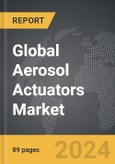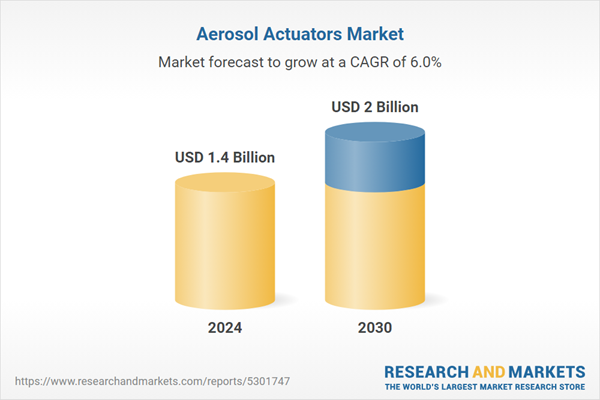Global Aerosol Actuators Market - Key Trends and Drivers Summarized
What Are Aerosol Actuators and Why Are They Important?
Aerosol actuators are essential components in spray dispensing systems that control the release of products stored in pressurized containers. These small but critical devices are the mechanisms that users engage - usually by pressing a button or nozzle - to release a controlled amount of product in the form of a fine mist, spray, or foam. Aerosol actuators are widely used across various industries, from personal care products such as deodorants and hair sprays to household cleaners, automotive sprays, and even medical devices like inhalers. The importance of aerosol actuators lies in their ability to deliver consistent, accurate, and efficient dosing of products, ensuring that users receive the right amount of the product every time. Beyond simple dispensing, advanced aerosol actuators can also be designed to influence the type of spray pattern, particle size, and even the speed of release, making them crucial for both user experience and the functionality of the product. With innovations in design and materials, aerosol actuators have evolved to provide greater precision, safety, and ease of use, making them indispensable in both consumer and industrial applications.How Do Aerosol Actuators Work?
Aerosol actuators work by triggering the release of a pressurized product stored inside an aerosol container. The system typically consists of a valve, actuator, and propellant, all working together to create a controlled spray. When the actuator button or nozzle is pressed, it opens the valve, allowing the pressurized propellant (usually a gas like butane or nitrogen) to push the product through the valve and out through the actuator's nozzle. The actuator's design determines how the product is dispensed - whether it forms a mist, a fine spray, a stream, or foam. The nozzle shape and orifice size, combined with the pressure inside the can, control the pattern, flow rate, and dispersion of the product. In more advanced aerosol actuators, features such as lockable nozzles, adjustable spray settings, or specialized foam patterns can be included to cater to specific applications. For example, in medical inhalers, precision is paramount, and the actuator must release a measured dose of medication at exactly the right particle size for effective lung delivery. Similarly, in personal care products like hairspray, the actuator must disperse the product evenly for optimal coverage. This intricate balance of design and functionality makes the aerosol actuator a key component in determining both the product's usability and performance.Why Are Aerosol Actuators Gaining Traction Across Multiple Industries?
Aerosol actuators are experiencing increased demand across various industries due to their versatility, ease of use, and growing consumer preference for convenient packaging solutions. In the personal care and cosmetics sector, aerosol actuators are essential for products like hair sprays, deodorants, and sunblock sprays, where users expect consistent and easy application. In the medical field, actuators used in metered-dose inhalers (MDIs) are critical for delivering controlled doses of medication, especially for conditions like asthma and COPD, where accurate dosing can be life-saving. Household products, including disinfectants, air fresheners, and cleaning sprays, also rely heavily on aerosol actuators to ensure efficient and mess-free application. The automotive industry similarly utilizes aerosol actuators in products like lubricants, paint sprays, and tire cleaners, where precision and controlled flow are necessary. Moreover, environmental concerns are also driving the development of more eco-friendly aerosol actuators, with many manufacturers shifting to sustainable materials and low-impact propellants to reduce their carbon footprint. As a result, the functionality and convenience offered by aerosol actuators are not only enhancing consumer experiences but are also addressing the evolving regulatory and environmental needs of the industries they serve.What’s Fueling the Growth of the Aerosol Actuator Market?
The growth in the aerosol actuator market is driven by several factors, primarily reflecting the increasing demand for convenience, safety, and sustainability in product packaging and delivery. One of the key drivers is the rising consumer preference for easy-to-use, portable, and efficient packaging solutions, particularly in personal care, cosmetics, and household products. Aerosol actuators provide an effortless way to apply products evenly and accurately, which has boosted their popularity in these sectors. Additionally, advancements in actuator technology, such as customizable spray patterns, precision dosing, and child-resistant mechanisms, have made aerosol products more attractive to both consumers and manufacturers. Another significant factor is the growing medical demand for aerosol-based drug delivery systems, particularly for respiratory conditions, where metered-dose inhalers require actuators that deliver accurate and consistent doses of medication. Environmental and regulatory factors are also playing a crucial role in market growth. As global regulations on propellants and packaging materials become more stringent, there is increasing investment in the development of eco-friendly actuators that work with low-global-warming-potential (GWP) propellants or even propellant-free systems. The shift toward recyclable materials and biodegradable options is further driving innovation in the design and manufacturing of aerosol actuators. Finally, the ongoing development of smart packaging solutions, including aerosol actuators that integrate with digital systems or provide real-time usage feedback, is opening new frontiers in product functionality and consumer engagement. These combined factors are propelling the aerosol actuator market toward sustained growth and innovation across multiple sectors.Report Scope
The report analyzes the Aerosol Actuators market, presented in terms of units. The analysis covers the key segments and geographic regions outlined below.Segments: Material (Aluminum, Steel-Tinplate, Other Materials); Application (Personal Care, Household, Automotive & Industrial, Food & Beverage, Paints, Healthcare, Other Applications).
Geographic Regions/Countries: World; United States; Canada; Japan; China; Europe (France; Germany; Italy; United Kingdom; Spain; Russia; and Rest of Europe); Asia-Pacific (Australia; India; South Korea; and Rest of Asia-Pacific); Latin America (Argentina; Brazil; Mexico; and Rest of Latin America); Middle East (Iran; Israel; Saudi Arabia; United Arab Emirates; and Rest of Middle East); and Africa.
Key Insights:
- Market Growth: Understand the significant growth trajectory of the Aluminum segment, which is expected to reach US$1.1 Billion by 2030 with a CAGR of a 6.1%. The Steel-Tinplate segment is also set to grow at 6.5% CAGR over the analysis period.
- Regional Analysis: Gain insights into the U.S. market, valued at $374.2 Million in 2024, and China, forecasted to grow at an impressive 9.1% CAGR to reach $468.0 Million by 2030. Discover growth trends in other key regions, including Japan, Canada, Germany, and the Asia-Pacific.
Why You Should Buy This Report:
- Detailed Market Analysis: Access a thorough analysis of the Global Aerosol Actuators Market, covering all major geographic regions and market segments.
- Competitive Insights: Get an overview of the competitive landscape, including the market presence of major players across different geographies.
- Future Trends and Drivers: Understand the key trends and drivers shaping the future of the Global Aerosol Actuators Market.
- Actionable Insights: Benefit from actionable insights that can help you identify new revenue opportunities and make strategic business decisions.
Key Questions Answered:
- How is the Global Aerosol Actuators Market expected to evolve by 2030?
- What are the main drivers and restraints affecting the market?
- Which market segments will grow the most over the forecast period?
- How will market shares for different regions and segments change by 2030?
- Who are the leading players in the market, and what are their prospects?
Report Features:
- Comprehensive Market Data: Independent analysis of annual sales and market forecasts in US$ Million from 2024 to 2030.
- In-Depth Regional Analysis: Detailed insights into key markets, including the U.S., China, Japan, Canada, Europe, Asia-Pacific, Latin America, Middle East, and Africa.
- Company Profiles: Coverage of players such as Aptar Group, Coster Group, E C Pack Industrial Ltd., Guangzhou Zop Aerosol Valves Co., Ltd., KOH-I-NOOR Mladá Vožice a.s. and more.
- Complimentary Updates: Receive free report updates for one year to keep you informed of the latest market developments.
Some of the 34 companies featured in this Aerosol Actuators market report include:
- Aptar Group
- Coster Group
- E C Pack Industrial Ltd.
- Guangzhou Zop Aerosol Valves Co., Ltd.
- KOH-I-NOOR Mladá Vožice a.s.
- Lindal Group
- Majesty Packaging Systems Limited
- Mitani Valve Co. Ltd
- Newman-Green Inc.
- Passport Manufacturing Ltd.
- Power Container Corporation
- Precision Valve Corporation
- Summit Packaging Systems Inc.
- Ultramotive Corporation
- YingBo Aerosol Valve (ZhongShan) Co., Ltd
Tariff Impact Analysis: Key Insights for 2025
Global tariff negotiations across 180+ countries are reshaping supply chains, costs, and competitiveness. This report reflects the latest developments as of April 2025 and incorporates forward-looking insights into the market outlook.The analysts continuously track trade developments worldwide, drawing insights from leading global economists and over 200 industry and policy institutions, including think tanks, trade organizations, and national economic advisory bodies. This intelligence is integrated into forecasting models to provide timely, data-driven analysis of emerging risks and opportunities.
What’s Included in This Edition:
- Tariff-adjusted market forecasts by region and segment
- Analysis of cost and supply chain implications by sourcing and trade exposure
- Strategic insights into geographic shifts
Buyers receive a free July 2025 update with:
- Finalized tariff impacts and new trade agreement effects
- Updated projections reflecting global sourcing and cost shifts
- Expanded country-specific coverage across the industry
Table of Contents
Companies Mentioned (Partial List)
A selection of companies mentioned in this report includes, but is not limited to:
- Aptar Group
- Coster Group
- E C Pack Industrial Ltd.
- Guangzhou Zop Aerosol Valves Co., Ltd.
- KOH-I-NOOR Mladá Vožice a.s.
- Lindal Group
- Majesty Packaging Systems Limited
- Mitani Valve Co. Ltd
- Newman-Green Inc.
- Passport Manufacturing Ltd.
- Power Container Corporation
- Precision Valve Corporation
- Summit Packaging Systems Inc.
- Ultramotive Corporation
- YingBo Aerosol Valve (ZhongShan) Co., Ltd
Table Information
| Report Attribute | Details |
|---|---|
| No. of Pages | 89 |
| Published | April 2025 |
| Forecast Period | 2024 - 2030 |
| Estimated Market Value ( USD | $ 1.4 Billion |
| Forecasted Market Value ( USD | $ 2 Billion |
| Compound Annual Growth Rate | 6.0% |
| Regions Covered | Global |









